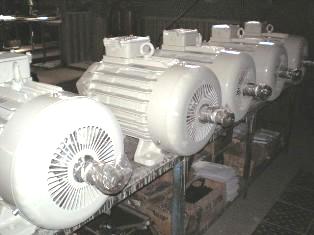Electric motors of cranes
 YES Wound electric motors with three-phase alternating current (asynchronous) and direct current (series or parallel excitation) they operate, as a rule, in a periodic mode with wide speed control, and their operation is accompanied by significant overloads, frequent starts, reverses and stops .
YES Wound electric motors with three-phase alternating current (asynchronous) and direct current (series or parallel excitation) they operate, as a rule, in a periodic mode with wide speed control, and their operation is accompanied by significant overloads, frequent starts, reverses and stops .
In addition, electric motors sanNew mechanisms work in conditions of increased shaking and vibration. In a number of metallurgical workshops, in addition to all this, they are exposed to high temperatures (up to 60-70 °C), vapors and gases.
In this regard, according to their technical and economic indicators and characteristics, crane electric motors differ significantly from electric motors with a general industrial design.
The main characteristics of crane electric motors:
-
implementation, normally closed,
-
insulating materials have heat resistance class F and H,
-
the moment of inertia of the rotor is as minimal as possible, and the reference speeds are relatively small — to reduce energy losses during transient processes,
-
the magnetic flux is relatively high—to provide a large overload torque,
-
short-term value of the overload torque for edged DC electric motors in hourly mode is 2.15 — 5.0 and for AC motors — 2.3 — 3.5,
-
the ratio of the maximum permissible operating speed to the nominal speed is 3.5 for direct current motors — 4.9, for alternating current motors 2.5,
-
for AC crane motors, the PV mode — 80 minutes (hourly) mode.

Crane electric motors with phase rotor crane mechanisms are installed on it under medium, heavy and very heavy operating conditions. Olya, recognize the regulation starting torque within the specified limits and speed regulation in the range (1: 3) — (1: 4).
Squirrel rotor asynchronous electric motors are used less often (for driving mechanisms of low-critical low-speed cranes) due to slightly reduced starting torque and significant inrush currents, although their mass is about 8% less than that of motors with a phase rotor, and the price is 1.3 times less than those of these motors with the same power.
Squirrel rotor induction motors are sometimes used in L and C modes (for lifting mechanisms). Their use on crane mechanisms operating in heavier modes is limited by the low allowable switching frequency and the complexity of the speed control circuits.
 The advantages of asynchronous electric motors compared to direct current electric motors are their relatively lower cost, ease of maintenance and repair.
The advantages of asynchronous electric motors compared to direct current electric motors are their relatively lower cost, ease of maintenance and repair.
The mass of the asynchronous electric motor of the faucet with external self-ventilation is 2.2 — 3 times smaller than the mass of the DC electric motor of the faucet at the same commemorative moments, and the mass of the copper is correspondingly about 5 times smaller.
If the operating costs are taken as a unit for asynchronous electric motors with a squirrel-cage rotor, then for electric motors with a wound rotor these costs will be 5, and for direct current motors 10. Therefore, in crane electric drives, AC motors are the most widely used (about 90% of the total number of electric motors) …
DC motors are used in cases where wide and smooth speed control is required, for drives with a large number of starts per hour, if it is necessary to adjust the speed upwards from the nominal, for operation in the G — D and TP — D systems Recently, in connection with the development of frequency controlled electric drive, DC motors began to be replaced by asynchronous electric motors working together with frequency converters.
Crane AC motors
In our country, asynchronous crane and metallurgical electric motors are produced in the power range 1 from 1.4 to 160 kW at duty cycle = 40%.

If the mains voltage of 60 Hz is 20% higher than the mains voltage of 50 Hz, then the rated power of the electric motor can be increased by 10-15%, and the set of starting currents and moments is approximately unchanged.
If the nominal voltage of the network at 50 Hz is equal to the nominal voltage at 60 Hz, then the increase in the nominal power is not allowed. In this case, the rated torque and the multiple of the maximum torque, the starting torque and the starting current are reduced according to the ratio: frequencies 50/60, i.e. with 17%.
 Domestic industry produces asynchronous crane electric motors with heat resistance class F, which are designated by the letters MTF (with phase rotor) and MTKF (with squirrel cage rotor)... Metallurgical asynchronous electric motors with heat resistance class H, which are designated MTN and MTKN ( respectively with phase or rotor with cell).
Domestic industry produces asynchronous crane electric motors with heat resistance class F, which are designated by the letters MTF (with phase rotor) and MTKF (with squirrel cage rotor)... Metallurgical asynchronous electric motors with heat resistance class H, which are designated MTN and MTKN ( respectively with phase or rotor with cell).
Electric motors of the MTF, MTKF, MTN and MTKN series are produced at a synchronous rotation frequency of 600, 750 and 1000 rpm at a frequency of 50 Hz and at 720, 900 and 1200 rpm at a frequency of 60 Hz.
Electric motors of the MTKN series are also produced in a two-speed version (synchronous speeds 1000/500, 1000/375, 1000/300 rpm), MTKF series - in two- and three-speed versions (synchronous speeds 1500/500, 1500/250, 1500/750, 250 rpm)/
Electric motors of the MTF, MTKF, MTN and MTKN series are characterized by increased overload capacity, large starting moments with relatively low starting current values and short starting (acceleration) time.
The power of the electric motors of the MTN series, thanks to the use of modern insulation materials, has been increased by one stage with the same overall dimensions compared to the previously produced electric motors of the MTM series.

-
increase in power at a given speed,
-
the presence of a four-pole version,
-
the probability of trouble-free operation during the warranty period is not less than 0.96 for crane electric motors and 0.98 for electric motors of metallurgical design, the average service life is 20 years,
-
reduced noise and vibration,
-
the use of new materials — cold-rolled electrical steel, insulating materials based on synthetic films and vinyl paper, enamelled wires with increased durability, etc.
-
expansion of the power scale of eight-pole electric motors up to 200 kW,
-
technically possible unification of electric motors of this series with electric motors of the 4A series,
The designation of 4MT series electric motors includes the height of the axis of rotation (mm) in the same way as for 4A series electric motors.
Crane DC motors
 Crane-metallurgical electric motors with direct current are produced in the power range from 2.5 to 185 kW at rotational speeds are produced with insulation of heat resistance class N.
Crane-metallurgical electric motors with direct current are produced in the power range from 2.5 to 185 kW at rotational speeds are produced with insulation of heat resistance class N.
Protection class of electric motors: AzP20 — for protected version with independent ventilation, AzP23 — for closed version. Bed electric motors from series D up to version 808 — integral, and starting from version 810 - detachable.
The field windings (parallel and mixed excitation) are designed for continuous operation, that is, they cannot be switched off during the stop period of the electric motor. Parallel excitation coils consist of two groups, which when switched on at 220 V are connected in series: at 110 V — in parallel, at 440 V — in series with additional resistors connected in series,
Motors are designed to control speed by weakening the magnetic flux or increasing the armature voltage.
Motors with parallel excitation and with a stabilizer winding allow an increase in the rotational frequency compared to the nominal one (low speed with a stabilizer winding — 2.5 times) by reducing the excitation current.
At such an increased speed of rotation, the maximum torque should not exceed 0.8 Mn — for electric motors with a voltage of 220 V and 0.64 Mn — for electric motors with a voltage of 440 V.
Electric motors for cranes


